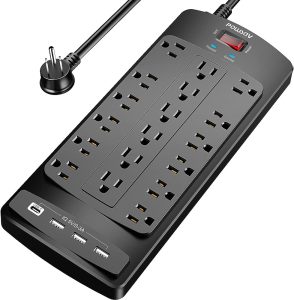Power surge protectors play a crucial role in safeguarding our electrical devices from the unpredictable spikes in electrical voltage that can occur. These surges can cause significant damage to electrical appliances, reducing their lifespan, and in worst-case scenarios, rendering them completely unusable. A power surge protector is an indispensable tool that acts as a barrier between your devices and the potential havoc that power surges can wreak.
Understanding Power Surges
Before delving into the benefits and specifics of power surge protectors, it’s essential to understand what power surges are and how they occur. A power surge is an unexpected increase in voltage significantly above the designated level in a flow of electricity. While the standard voltage level in U.S. homes is 120 volts, during a surge, this level can spike up to thousands of volts for a brief moment.
Common Causes of Power Surges
- Lightning Strikes: Lightning can induce high-energy electrical surges in nearby power lines, leading to potential damage to connected devices.
- High-Power Electrical Devices: Devices that require a significant amount of power to switch on or off, such as air conditioners and refrigerators, can generate surges that affect the entire electrical system.
- Faulty Wiring and Downed Power Lines: These can also be a source of power surges, posing a risk to electrical safety and equipment integrity.
The Role of Power Surge Protectors
Power surge protectors monitor the electrical current and divert excess voltage away from your devices, preventing damage. They come in various sizes, specifications, and price points to suit different needs and budgets.
Key Features to Consider
- Joule Rating: This indicates the energy capacity of the surge protector. A higher joule rating means better protection. For most home electronics, a protector with a rating of 600 to 2000 joules is sufficient.
- Response Time: Surge protectors have a response time, usually measured in nanoseconds. A quicker response time means faster protection for your devices.
- Clamping Voltage: This is the voltage level at which the surge protector starts to divert excess electricity. Lower clamping voltage indicates better protection.
- Number of Outlets and USB Ports: Depending on your needs, you might require a surge protector with multiple outlets and USB ports for convenience.

Economic and Efficiency Considerations
When selecting a power surge protector, it’s vital to balance cost, efficiency, and the level of protection needed. The initial cost of a surge protector can range from $20 to $200, depending on its features and specifications. However, investing in a high-quality surge protector can save considerable money in the long run by preventing damage to expensive electronics.
- Cost-Effectiveness: The right surge protector can extend the lifespan of your devices, offering a high return on investment.
- Efficiency: High-quality surge protectors maintain electrical flow efficiency, ensuring that your devices operate without interruption or damage.
- Material Quality: Durable materials and superior construction quality ensure that your surge protector can withstand multiple surges over its lifespan, which can be anywhere from three to five years, depending on usage and surge frequency.
Conclusion
Investing in a high-quality power surge protector is a smart decision for anyone looking to protect their electrical devices from damage. By understanding the specifics of power surges and the features of surge protectors, you can make an informed choice that balances cost, efficiency, and protection level. Remember, the right surge protector acts not just as a line of defense but also as an investment in the longevity and reliability of your electrical devices.